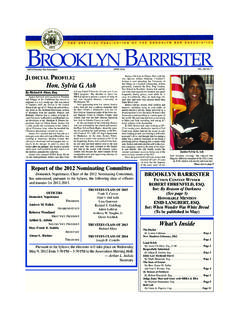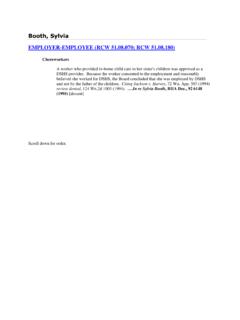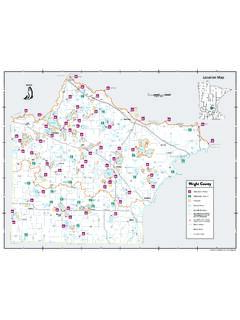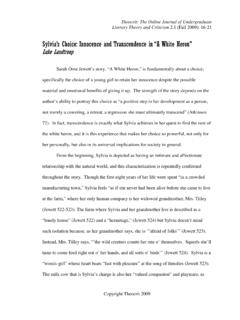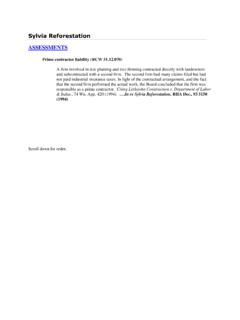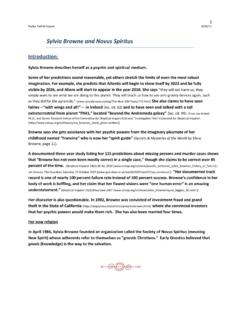Transcription of Aalborg Universitet Key Concepts in Feminist Theory Walby ...
1 Aalborg UniversitetKey Concepts in Feminist TheoryWalby, SylviaDOI (link to publication from Publisher) date:1996 Document VersionPublisher's PDF, also known as Version of recordLink to publication from Aalborg UniversityCitation for published version (APA): Walby , S. (1996). Key Concepts in Feminist Theory . Aalborg : Department of History, International and SocialStudies, Aalborg University. FREIA's tekstserie, No. 33 rightsCopyright and moral rights for the publications made accessible in the public portal are retained by the authors and/or other copyright ownersand it is a condition of accessing publications that users recognise and abide by the legal requirements associated with these rights. ? Users may download and print one copy of any publication from the public portal for the purpose of private study or research. ? You may not further distribute the material or use it for any profit-making activity or commercial gain ?
2 You may freely distribute the URL identifying the publication in the public portal ?Take down policyIf you believe that this document breaches copyright please contact us at providing details, and we will remove access tothe work immediately and investigate your from on: October 16, 2019 sylvia Walby Key Concepts in Feminist Theory Paper FREIA December 1996 33 Feminist Research Centre in Aalborg Department of Development and Planning Aalborg University Fibigerstraede 2 DK-9220 Aalborg . Phone: +45 98-158522 Fax: +45 98-153298 sylvia Walby : Key Concepts in Feminist Theory Paper from FREIA - Feminist Research Centre in Aalborg Department of Development and Planning Aalborg University Fibigerstraede 2 DK-9220 Aalborg Phone: +45 98 158522 Print: Kopicentralen, Aalborg University, 1996 Layout: Inger Jensen and Ellen Nyrup Pedersen ISSN: 0907-2179 FREIA's paper series contains working papers, papers for conferences and seminars, project descriptions, lecture manuscripts, chapters from books etc.
3 The papers are made by researchers affiliated to FREIA or by researchers who have visited the centre. The paper series aims at spreading the knowledge of FREIA's activities, internally as well as externally. Editors of the series are Ann-Dorte Christensen and Ruth Emerek. The papers can be ordered at Aalborg University, Department of Development and Planning, phone: +45 98 158522, ext. 2452. sylvia Walby Key Concepts in Feminist Theory 1 Introduction The key questions which this paper has been asked to address are whether women are 'empowered' or 'victimised' by their entry into the public sphere and which Concepts are best to address this issue. The central issue is thus the theorisation of changes in gender relations, especially women's increasing integration and participation in the labour market and formal politics in the West, in particular in 'modern welfare states'.
4 The Concepts which might be used to capture these changes might include: 'participation', 'integration' , 'exclusion', 'marginalisation', and 'segregation'. I shall argue for the need for macro level Concepts to capture changes at the societal level, such as that of 'patriarchy', as well as mid-level Concepts such as these. I shall argue that an answer these questions concerning the position of women requires a Theory of patriarchy, one which is both structural enough to grasp the scale and interconnectedness of these changes on a macro level, while flexible enough to capture change and diversity. Thus I would add: 'patriarchy' to this list of key Feminist Concepts . The most effective route to conceptualising these issues is to develop the notion of different forms of patriarchy: that is, the differences between more public and more private forms of patriarchy; the separation of different degrees of patriarchy; the distinguishing of six patriarchal structures in paid employment, the household, the state, male violence, culture and sexuality; and differentiating more detailed patriarchal practices within these.
5 Further, that it is essential to separate degree and form of patriarchy. These ideas are based in Theorising Patriarchy, developed in 'Methodological and theoretical issues in the comparative analysis of gender relations in Western Europe' (1994), and further developed in Gender Transformations (1997). 2 'Victimised' or 'empowered'? There is an issue in Feminist Theory , as in all social Theory , as to the relationship between agency and structure. This issue arises in an acute form in the debates on the theorisation of changes in gender relations and in particular in relation to the question of whether women are 'victimised' or 'empowered' as a result of these changes. There is a constant dilemma in Feminist Theory over the extent to which women's actions are seen to be constrained by social, in particular, patriarchal structures. On the one hand, if the account is theoretically led by structural Concepts there is a danger that women are seen as passive victims.
6 This approach has been heavily criticised as inappropriately denying women agency. Theories which conceptualise gender relations in terms of patriarchal structures have often been criticised for inevitably viewing women as victims and underestimating women's agency and capacity to political action. On the other hand, if the account is theoretically led by voluntarist Concepts of women's actions, then there is a danger that women will be seen to be colluding with their patriarchal oppressors. If women are seen to have full agency and decision making powers, this may lead to the view that women are then choosing or collaborating with their oppressors. This approach can be criticised for inappropriately suggesting that women actively create their own oppression. This issue of structure and agency is a classic dilemma in all social Theory . I have mapped it out here as a choice between two symmetrically problematic positions.
7 The dilemma is that if women are seen as having agency then they must be seen as choosing their oppression, and if they do not choose it, as in structural account, then they are merely passive victims. The problem with such an approach which dichotomises structure and agency is, as Giddens (1984) has repeatedly pointed out, that it neglects the duality of structure as being composed both of institutions and 3agency. Social science must have Concepts which allow for both the abstraction of institutional formations, which are beyond and above any individual action, as well as recognising the reflexivity of human actors. We need Concepts which mean that we do not have to choose between an account led by either structure or agency, but one in which they are seen as mutually compatible, co-existing and complementary. I would argue that it is possible to do this within a Theory of patriarchy. That such a Theory does not inevitably neglect women's, nor indeed men's, agency and political action.
8 One example of this is the explanation of the change from private to public patriarchy in Theorising Patriarchy ( Walby 1990). Here the changes are explained as a result not only of structural change, in particular changes in the capitalist economy which led to an increased demand for waged labour; but also as a result of the power of organised feminism at the turn of the century and its successful campaign for political citizenship. It is this focus on the importance of women's collective agency, as a political movement, which clearly gives place to women's agency in the creation of new structures of gender relations, new forms of patriarchy. A second example, from Patriarchy at Work ( Walby 1986), is of the importance of men's organisations in restricting women's access to the better forms of paid work, of the role of some trade unions in creating sex segregation, that is men's agency leading to a structured patriarchal practice or institution.
9 The impact of men's activities on the extent and nature of women's participation in paid work depended significantly upon the structural context, in particular, upon the balance of patriarchal and capitalist forces. It is important to acknowledge the importance of men's agency in theorising gender relations. Men have often been active in building institutions which suit their needs rather than those of women. Men's traditionally greater access to and involvement in the public sphere has typically given them greater opportunities for effective collective agency than have traditionally been available to women. A related example is that of the analysis of male 4 political opposition to first wave feminism, and the specificity of the concept of backlash in the comparison of the US and the UK ( Walby , 1991). These examples have been of collective agency rather than individual agency. Many of the interventions in the debates about women's agency have tended to focus on individual agency.
10 This latter focus has a tendency to underestimate the extent to which women while always making active choices do not do so under circumstances of their own choosing. However, I think it is possible to simultaneously hold that women actively make choices, which doing so in conditions which are determined by institutions and structures over which they do not have power. Contemporary increases in women's employment: are younger women 'empowered' and older women 'victimised'? 5 One of the central questions to be addressed is whether the increasing participation of women in the public sphere, especially employment, empowers them. Some writers have argued that women's participation in paid work is key to women's emancipation, while others see its effects as either neutral or contingent (Elson and Pearson, 1981; Lim, 1991; Tinker, 1991). On the one hand it can be argued that being paid for work (usually outside the home) is an improvement over working for no pay (usually within the home); that this can give women a degree of autonomy and independence from the men with whom they might live; and that this has positive implications for women's ability to participate in wider forms of decision making, for instance in elected parliaments and as members of significant professional groups, such as judges.


